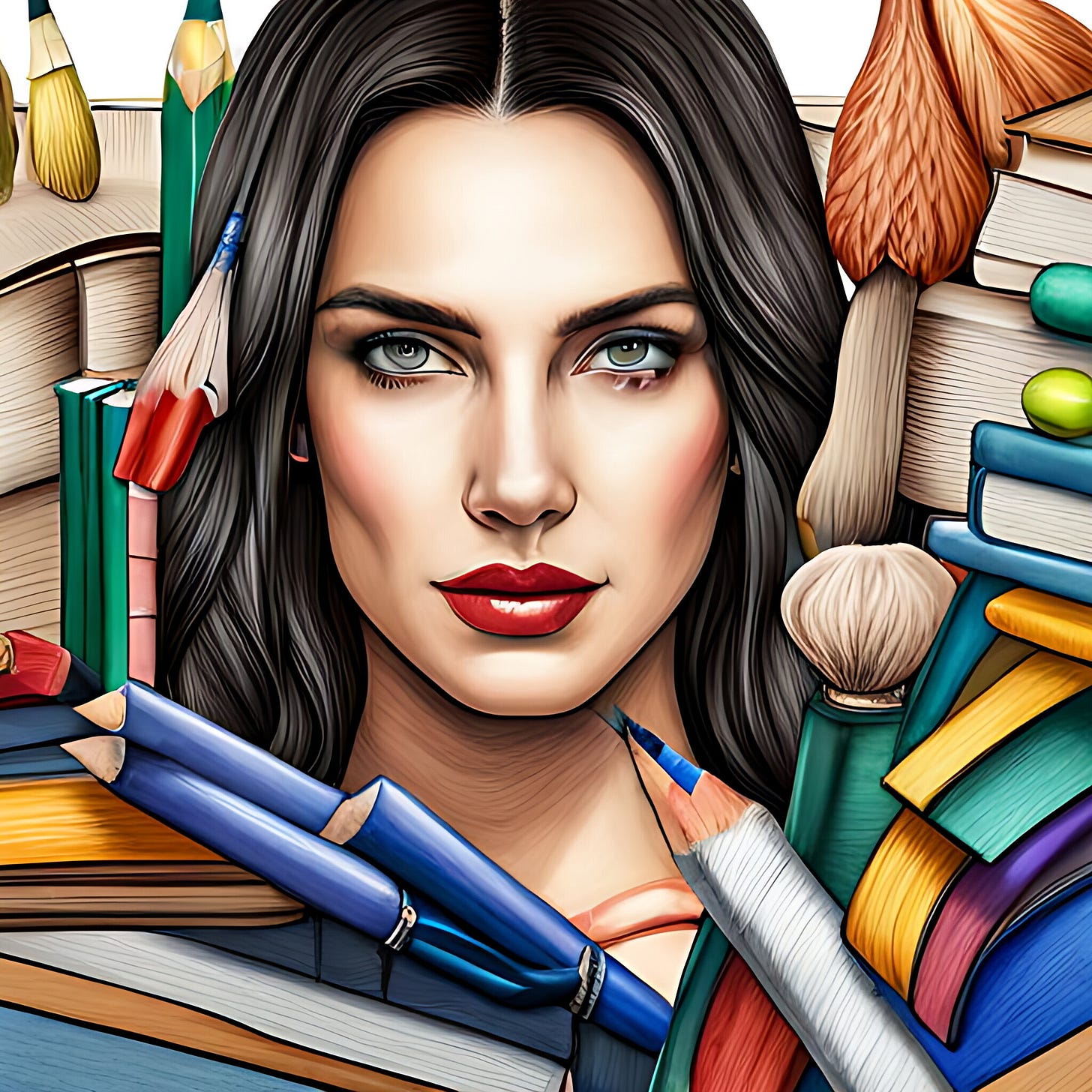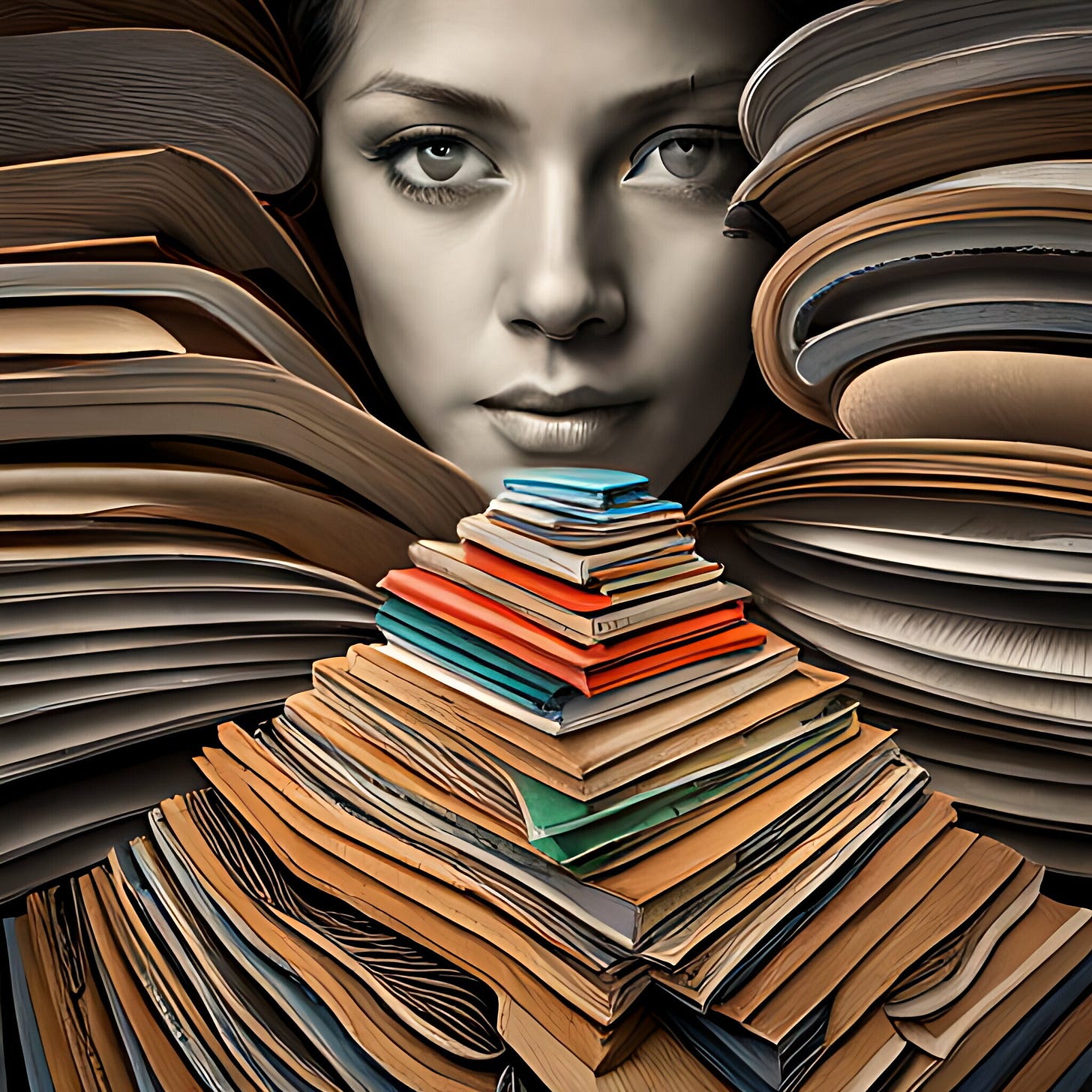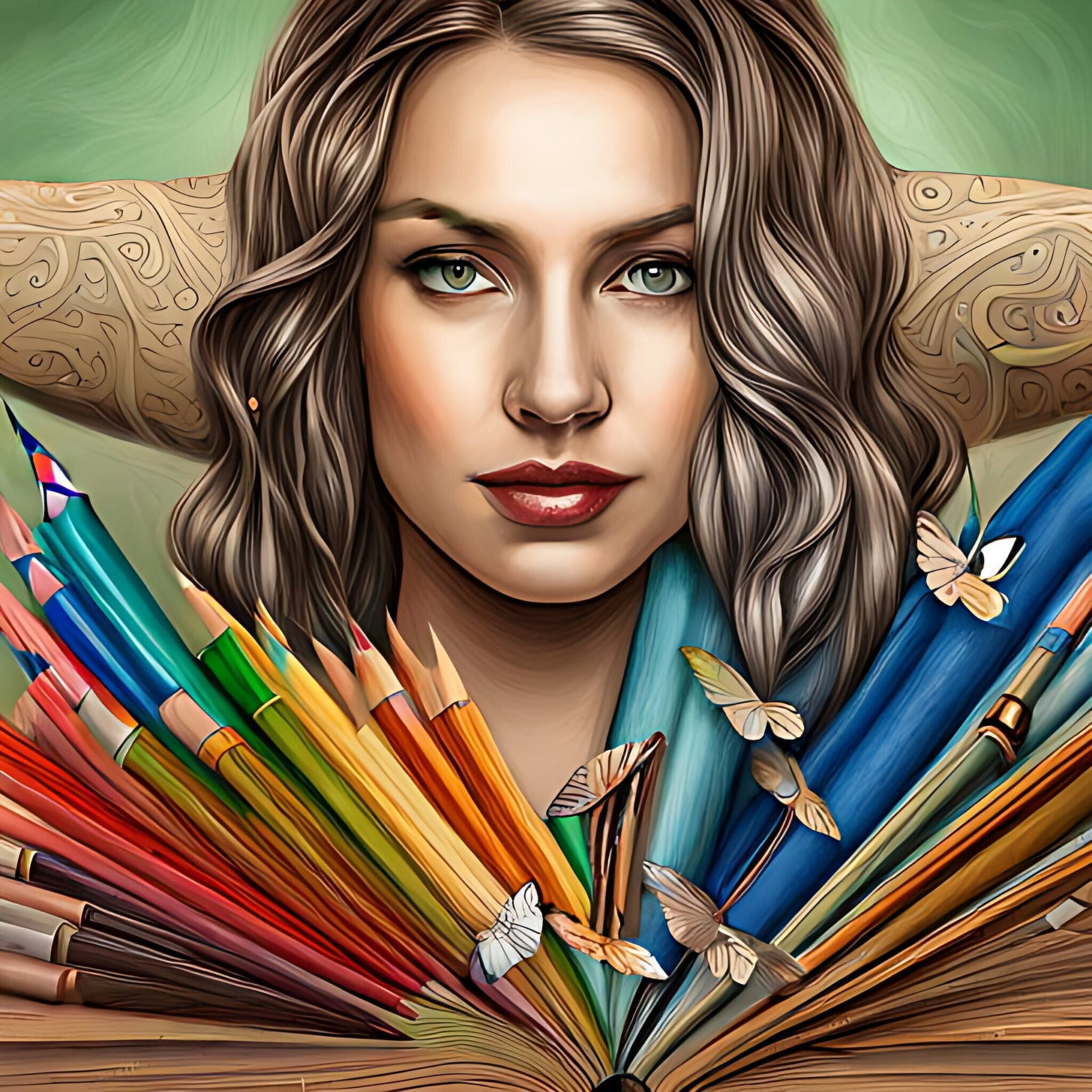Things I Said in Substack Notes This Week and Have More To Say About
A weekly column for connecting further and deeper on topics I care about because the conversations here are just so rich and wonderful
This is my weekly free column rounding up things I shared on Notes. I elaborate a little on them, especially trying to emphasize the relationship between art and mental health, which is my specific writing and research niche. (And I believe that all of us are artists and all face mental health challenges to varying degrees.) I hope it also introduces you to writers that you want to get to know better.

Housekeeping:
I’ve made it so that you can opt out of the types of posts here that you don’t want email notifications for. Learn more here.
I’ve created my Table of Contents where you can see all of my post types and the posts available in each one.
If you enjoy my weekly digests, then you might like the new one coming out that’s all the writing about writing. This one is for paying subscribers.
A FRAMEWORK TO BEGIN:
wrote Write Less, Please which is a great smart piece that will be helpful to a lot of people. It also sparked tons of comments and restacks and a great conversation about writing.The advice in it is mostly not right for me right now. I came back to longform writing after years of feeling very restricted by the best practices of online writing which, it’s true, are shorter formats. So I’m here for the long stuff. I write it, but moreover I read it here.
But her words have a lot of value especially for people who are relatively new to making an online income with writing. And something I re-shared that’s relevant as we begin this roundup is:
“Because they’re reading on screen, they’ll have a surface-level reading experience that will prevent them from remembering, analyzing, drawing comparisons about, or feeling empathy as a result of your post.”
Because that’s very true and it inspired me to share:
Every week, I do my Link Love roundup of the posts that inspired me in my particular niche and my additional thoughts on them. I also do a post of some of the conversations I’ve been having on Notes and elaborate on those. This takes a lot of time each week but I do it for exactly the reason Sarah mentions here … because it would be easy to just skim the content of people I subscribe to but I get a much richer, deeper experience of their work when I engage with it in this way.
So that’s part of why I do these weekly Notes roundups and I think it’s part of why many of you have said that you enjoy them.
INSPIRATION CHECK-IN:
Happy Tuesday check in!
I am reading: Kintsugi - the Japanese art of embracing the imperfect and loving your flaws
I am listening to: Kelly Clarkson’s newest album, loving the song Skip This Part
I am (re)watching: Oz
I am discussing: perimenopause, birth control and Ayurveda - turning to my women friends for guidance as I try to sort out this change
I am writing: overviews of different types of therapy for a website
I am feeling: a little overwhelmed but also more confident in my ability to create some spaciousness
I am excited about: going back to grad school soon!
What about you?!?!
Some weeks a lot of people respond to these and some weeks nobody responds. I haven’t quite figured out how Substack delivers my Notes to others and who sees what. But if you’d like to respond now with what’s inspiring you, here’s that Note where you can do so:
As you can see, I had included a picture of the sneakers I was wearing and
complimented them to which I shared:The shoes are actually a big deal because I fractured my ankle last fall and re-injured it in the spring. It was a rough year in many, many ways. After the injury, I bought several pairs of super supportive boots that really care for the ankle. This was the first time since then that I’ve worn shoes that weren’t those boots. They’re still supportive but obviously not covering/protecting the ankle and it represents that I am finally feeling steady on my feet again - physically as well as more metaphorically.
It really was a hard, hard year. My depression came back with a vengeance. My finances went into the toilet. I got COVID. I broke my ankle and couldn’t walk my new puppy nearly enough which created problems with training that we’re still working on. My father died. My father died. I’ve been literally unsteady on my feet for almost a year and emotionally unsteady for about the same amount of time and it feels really good to recognize that for this moment I’m actually starting to feel steady again.
I SHARED:
This favorite quote:
“I have come to the frightening conclusion that I am the decisive element. It is my personal approach that creates the climate. It is my daily mood that makes the weather. I possess tremendous power to make life miserable or joyous. I can be a tool of torture or an instrument of inspiration, I can humiliate or humor, hurt or heal. In all situations, it is my response that decides whether a crisis is escalated or de-escalated, and a person is humanized or de-humanized. If we treat people as they are, we make them worse. If we treat people as they ought to be, we help them become what they are capable of becoming.” - Haim G. Ginott
What’s fun about sharing this is that I had always seen it attributed to Goethe and always known that may not be right. So I did some research and found that it’s Haim G. Ginott who said it. However, this popular version of it might be a paraphrase because from what I can tell his original version was more specific to being a teacher.
I AM THINKING MORE ABOUT:
responded to one of my guest posts with:“This is really interesting - I also wonder, if artists in general just tend to feel/take in more overall, which can come out in the form of their work but can also be overwhelming and lead to mental health issues.”
To which I responded:
That’s an interesting perspective. I do think we are Whole mind-body-spirits and not separate parts so the same things that open someone to sensitivity to the arts could open someone to sensitivities of the mind. Something to ponder further.
As I think about it, I think this is a Yes/And topic for me. I stand by what I said and remain curious about ongoing research into this link. And I also think that it’s worth questioning whether there’s truth to the idea that artists feel more overall. It’s something we all generally agree on and intuitively might feel is true … but it’s worth at least continuing to examine.
As I often say, I believe that we are all artists/creatives who all have mental health experiences … maybe one way of looking at the “artist” spectrum is not just in terms of how people self-define as creative but in questions such as: “on a scale of 1 - 10, how much do you feel like you take in emotionally?” That question needs refining but the idea is one for me to hang on to as I further develop my thoughts on the artist/wellness spectrum framework.
We are all artists with mental health experiences
When people ask what I write about, I try succinctly to explain that I write at the intersection of art and mental health. Naturally, most people assume that I write about art as therap…
I ASKED:
I just signed up for this because I’m excited to have these conversations with smart Substackers. Who will be joining me?
“This” is an offering from
:“The Substack Soirée is a supportive group programme for anyone looking to start, grow or expand their Substack presence.
This (five week long online) class combines our decades of wisdom and insight into audience growth, online marketing, writing and storytelling with the factors we believe matter the most: community, compassion and creativity.”
I am certainly excited about what I can learn but even more that that I’m excited to connect with
and as well as the people who sign up for the class. The opportunity to engage with that live energy in these discussions is very appealing to me right now, so I’m excited and decided it was worth my investment.Others who said they’re joining include
, , and .(Side note about investment … I practice artistic tithing so a minimum of ten percent of my income, and usually it’s more, goes directly back to other writers/artists/performers/makers. So taking this class with them is one example of that. I don’t have to move things around in my budget because I’ve already set aside part of my budget for these things.)
PLEASE HELP ME MEET MY GOAL:
My goal is to find 1000 people who are interested in subscribing to this work at a rate of $100 per year. This shows the world that we as creatives believe artists and writers can and should earn six figures. Because I practice artistic tithing, if I meet this goal then we keep at least $10000 of that right in the creative community. I also make every effort to continuously encourage, support, share and promote the work of others.
$100 per year feels like a lot. But it works out to less than $2 per week.
If this is something that you believe in, I really need the support of paid subscriptions to be able to keep doing this work that I’m deeply committed to. In fact, I believe in this work so much that I’ve self-funded a year of full-time work here using a business loan. If I don’t reach the above goal by Summer 2024, I may have to revisit things.
See benefits for paid subscribers here. On a really tight budget? Learn about my Pay What You Can option here.
I ANSWERED:
This was in comments, not Notes, but I wanted to share it because it elaborates on some things shared in yesterday’s art and mental health link roundup about music. Original article was On the interplay between silence and music in art by Shinjini of
:A DISCUSSION:
I shared that I like most things about Substack but one small thing I’d love to see change is the ability to toggle on / off what activity we see in the app. That’s not an option right? Like if I only want to see replies in my activity section and not likes, follows, etc …
replied:“Seeing Likes is really making the Notes experience unpleasant. Especially bc people I follow seem to be “Like Happy”. I don’t think they realize how often they do it or how it is making timelines look weird when they Like things out of the norm.
It’s forcing me to unfollow a lot of people. Seems to be the only way to fix this issue.”
And Andrew Smith of
replied to her:“I agree with this (sorry I liked your post, Erica, but it’s pertinent and should be amplified). I think a lot of folks will simply check out of following more people if this is the case.”
I answered each of them:
Oh interesting. I like a ton of stuff, and I don’t want to stop doing that or have people not do it on mine. I just want to be able to turn it off so that I only see what I want to see in the notifications itself. Either a toggle on/off or a tab selection where I could choose to see each specific thing in its own tab. So if I only want to see replies, I can choose just that tab.
Is there a way to submit ideas like this to Substack? I’m not sure who the right people are to tag?
?Interestingly it’s the notification about more people following me right now that prompted me to post this :) Not that I get some amazing ton of followers or that it’s a problem I don’t want to have, but when that got added to “activity” I began to feel really overwhelmed on top of the “likes” and the “restacks” … I love the option to see everything but I don’t want that to be the only option.
I apparently use the word interesting a lot :) But I’d love to know what more people think about this topic?
I RESONATED:
of Slower Space said:“Just had a moment of gratitude and realisation that Substack is really giving me back the joy of creating and connection online 😌 I love my little ritual of writing first thing on a Monday morning and finding it’s really setting me up for the week.
Lots of people echoed the same sentiment in the comments. I said:
Absolutely feel this same way. I had gotten so disillusioned and burned out with “creating content” in recent years and my time on Substack has shifted that in the best possible way. I love the routine of reading and writing I’ve established here.
I want to add, though, that I am currently working only a little bit on stuff that pays me and putting full-time work into Substack. I’m doing that because I believe in my work and have faith that others will too and that therefore I should put it into the world. However, as aforementioned, I’m supporting myself with a business loan and not really making money on Substack. So it’s very emotionally fulfilling right now but we’ll see if that translates into something financially sustainable.
I RESTACKED:
This vivid thought from
of Bad At Keeping Secrets in Do Intentions Matter:“I don’t like sitting with people who are uncomfortable. Who are in pain. This was kinda like sitting next to someone who has just cut their finger off and having no medical expertise. You just have to sit with them and watch it bleed.”
One of the biggest lessons that I learned when I went to grad school for counseling psychology was the power of holding space for people. Probably like a whole lot of other people who go into therapy studies/work, I come from a background of being a “fixer” or a “solver” or, if I’m really honest, trying hard to control the situation because I don’t like to be uncomfortable. Therapy isn’t about a professional fixing you. You aren’t broken. It’s about allowing you to be your full self and sitting there in the presence of that even when it’s really hard.
(Also this, from a really poignant post about suicide called Touching the Void by
…“Your pain is terrible but I don’t mind. I’d stand beside you a thousand times over rather than wish you gone.”
There were a lot of things in Carissa’s post I could have restacked. It’s about intention vs. action. As I said in the comments there, this also relates to a key lesson from grad school:
This was one of the first things we learned in grad school for counseling psychology: intent vs impact ... the idea there was mostly that despite our best intentions we impact people in myriad ways and that self-awareness requires understanding this.
We practiced the story script: “I felt x when you y ... the story I am telling myself is z ... I want to check if that’s true”. It felt super cheesy to work with it but it’s a great tool. It acknowledges that something had an impact and we’ve created a whole story around it but are willing to listen to what the intention actually was.
I LOVED LEARNING:
I cross posted my Richard Dadd excerpt on
and said:I recently portrayed Van Gogh at the Detroit Institute of Arts. Looking forward to reading the book.
I honestly couldn’t imagine what that might mean, and I had to know more.
Detroit History Tours threw an art scavenger hunt at the DIA. One of the huntable items was Van Gogh, played by me. Contestants had to find me, then escort me to my self portrait for a selfie. The entire thing was an enormous challenge, though it was a ton of fun. It's an upbeat event, so I had to skew my portrayal to the more poetic, inquisitive parts of the artist, plus play the wonder at modern technology, as though some sort of time machine brought me there. The Postman is across the gallery from the self portrait, so I often expressed my pleasure at seeing my painting of my friend Joseph. Really, I think I did a decent job of playing a troubled man while still engaging guests and doing my best to answer questions. There's a dialect education website I love that gave me a basic groundwork for what Vincent might have sounded like speaking English, but maintaining that dialect during extemporaneous answers to questions from multiple excited, hurried scavenger hunters is like juggling flames with your tongue.
Part of what I answered:
I have a long history of depression and what your piece got me thinking about was how most of us with functional mental health challenges experience a lot of times when we have to be performative. I picture the real Van Gogh living today with depression or whatever challenge he may have and in order to promote his work or make ends meet or whatever he needs to go to a museum and greet guests and he does his best to put on a smile and engage with people. And it can be draining and awful but it can also be slightly energizing and inspiring even if it’s hard. At least that’s been my personal experience of this type of thing. So it actually sounds to me like your efforts to be his “best” self while still portraying the complexity of him are actually probably pretty authentic to the artist himself. If that makes sense?
It sounds like such a creative way to bring history to life and I love that there’s a mental health element to it, obvious or not. <3 One of my goals is to consult with art museums about mental health for visitors, staff, and artists and creative ideas like this always pique my interest.
I WANT TO THANK:
Some of the other people that I had little exchanges with in Notes or who re-stacked my work this week include:
Thanks so much for the conversations! And of course, I want to once again thank the people on my virtual book tour who shared my work this week:
I love collaborating. Want to guest post here about art and mental health? Do an email interview with me? Invite me to do the same on your site or podcast? Swap recommendations? Tell me … (Kathryn.vercillo on gmail)













I’ll be joining you at the Soiree Kathryn, look forward to ‘meeting’ and chatting! Received a paycheck today that was the exact amount of the program, with one day left of the Early bird offer. The universe knows I need this right now! :D
Kathryn were so excited you’ll be at the soirée! I can’t wait to meet you properly & chat under the fairy lights. Also! Your artistic tithing idea is freak-ING brilliant!! ❤️